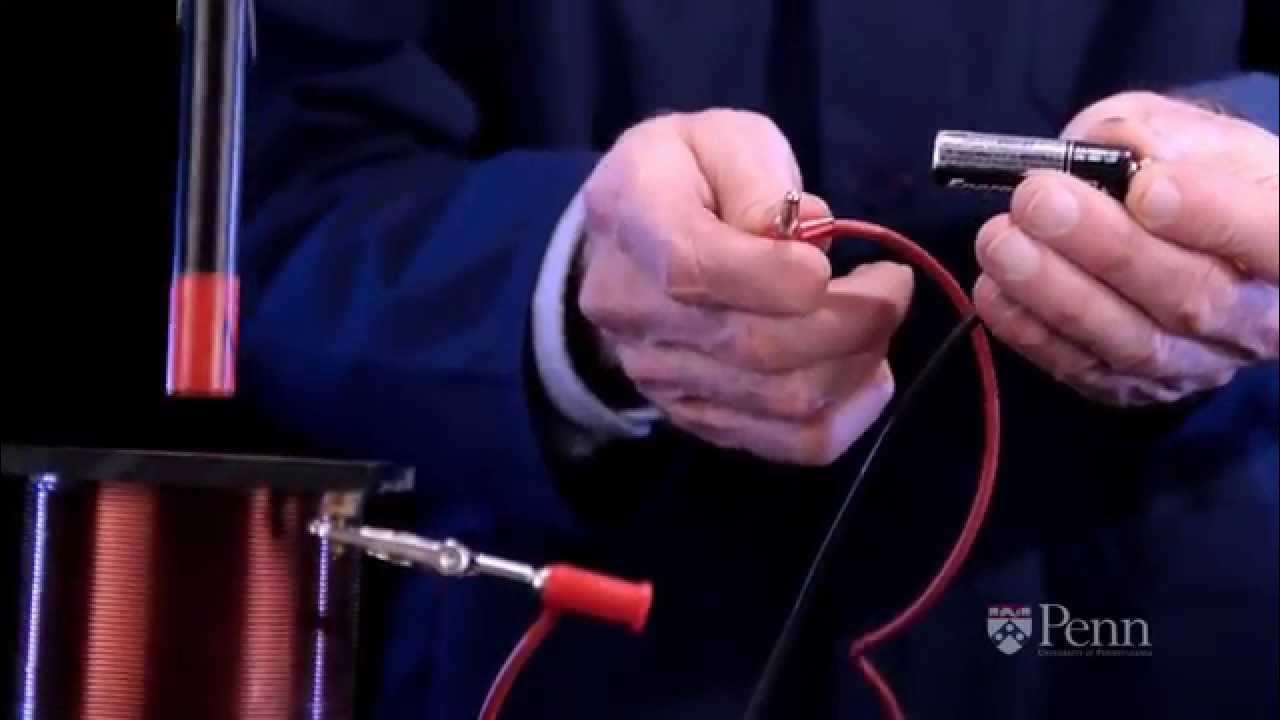Materi Kemagnetan Kelas 9 (Part-5) Induksi Elektromagnetik
Summary
TLDRIn this video, the concept of electromagnetic induction is explored, explaining how a magnetic field can generate electricity. The historical experiments by Michael Faraday and Joseph Henry are introduced, demonstrating how movement of a magnet inside a coil induces an electric current. Factors influencing the induced current, such as the number of coil turns, speed of movement, and magnet strength, are discussed. The video also highlights practical applications, including generators, dynamos, and transformers, illustrating how these devices generate and manage electricity, from hydroelectric plants to household use, through electromagnetic induction.
Takeaways
- 😀 Electromagnetic induction is the process of generating electricity through the movement of magnets or coils.
- 😀 Michael Faraday and Joseph Henry discovered the concept of electromagnetic induction in 1831.
- 😀 A galvanometer is used to detect the presence of electrical current when the needle deflects, indicating the flow of electricity.
- 😀 Moving a magnet in and out of a coil induces electrical current, as shown in Faraday's experiments.
- 😀 Induced electric current occurs only when the magnetic field changes, not when the magnet is stationary.
- 😀 GGL (Induced Electromotive Force) is generated by the change in the magnetic field caused by movement.
- 😀 The speed of magnet movement, number of coil windings, and strength of the magnet all influence the amount of induced current.
- 😀 More coil windings result in a greater induced electric current.
- 😀 A stronger magnet generates more electrical current, but the size of the magnet itself does not matter as much as its strength.
- 😀 Practical applications of electromagnetic induction include generators, dynamos, and transformers.
- 😀 Generators convert mechanical energy (like from water in a hydroelectric dam) into electrical energy, while dynamos generate electricity for smaller devices like bicycle lamps.
- 😀 Transformers adjust electrical voltage for safe transmission and use, either stepping it up or stepping it down to match necessary levels for consumption.
Q & A
What is electromagnetic induction?
-Electromagnetic induction is the process where a magnetic field moving through a coil (or vice versa) generates an electric current. This concept was discovered by Michael Faraday and Joseph Henry in the 1830s.
How does electricity generate from a magnet according to the script?
-Electricity is generated by moving a magnet through a coil. This movement causes a change in the magnetic field lines, which induces an electric current in the coil.
What was the main experiment conducted by Faraday and Henry to demonstrate electromagnetic induction?
-The main experiment involved moving a magnet in and out of a coil of copper wire and observing the resulting electrical current using instruments like a galvanometer, voltmeter, or a lamp to detect the flow of electricity.
What is a galvanometer used for in the context of electromagnetic induction?
-A galvanometer is used to detect the presence of an electric current. If the needle moves, it indicates that an electrical current has been induced.
Why does no current flow when the magnet is stationary?
-When the magnet is stationary, there is no change in the magnetic field lines, which means no electrical current is induced in the coil.
What factors affect the magnitude of the induced current in electromagnetic induction?
-The factors that influence the induced current include the number of turns in the coil (more turns result in a stronger current), the speed at which the magnet or coil moves (faster movement generates a stronger current), and the strength of the magnet (a stronger magnet produces a greater current).
What are some real-world applications of electromagnetic induction mentioned in the script?
-Applications of electromagnetic induction include generators, dynamos, and transformers. These devices use the principles of electromagnetic induction to generate electricity or modify voltage.
How does a generator work based on electromagnetic induction?
-In a generator, a turbine powered by water or another energy source spins a magnet or coil, which induces an electric current through the coil, and the electricity is then transmitted for use.
What is the function of a dynamo, and how does it relate to electromagnetic induction?
-A dynamo, such as the one in a bicycle, uses the motion of the wheel to turn a magnet and a coil, generating electricity to power devices like the bicycle's light.
What is the role of transformers in electricity distribution?
-Transformers adjust the voltage of electricity, either stepping it up or stepping it down, to ensure that electricity is delivered safely to homes and industries. For example, they lower the voltage from high transmission levels to safer levels for residential use.
Outlines

This section is available to paid users only. Please upgrade to access this part.
Upgrade NowMindmap

This section is available to paid users only. Please upgrade to access this part.
Upgrade NowKeywords

This section is available to paid users only. Please upgrade to access this part.
Upgrade NowHighlights

This section is available to paid users only. Please upgrade to access this part.
Upgrade NowTranscripts

This section is available to paid users only. Please upgrade to access this part.
Upgrade NowBrowse More Related Video

Simulasi Magnet dan Induksi Elektromagnetik Menggunakan PHET

FISICA Tappabuchi#4 - INDUZIONE MAGNETICA, CORRENTE INDOTTA, LEGGE di FARADAY-NEUMANN-LENTZ

Faraday's Law of Induction Demonstration - Penn Physics

Electromagnetic Induction Revision in 20 minute || Chapter 6 class 12 Physics oneshot || CBSE/MP/UP

Listrik Magnet 13.4 Elektrodinamika Induksi Elektromagnetik Hukum Faraday

GAYA GERAK LISTRIK | KELAS XII | FISIKA ITU MUDAH [Nabila Ratna Az-Zahra]
5.0 / 5 (0 votes)